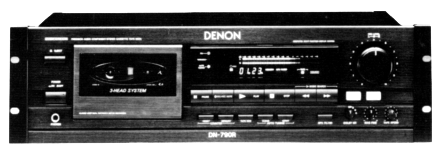
by Jerry Vigil
In this world of digital this and digital that, one might think the analog cassette deck is nearing extinction. But look around you. Every radio production room has one. Clients need their spots on cassette. Cassettes are still the easiest and least expensive way to distribute audio of all types, from music and air checks to demos and special programs. Everyone has a cassette deck! Most people, including those NOT in radio, have them in their car as well as at home. The analog cassette is still a standard in and out of our industry. But the fact that it's analog doesn't mean it has to sound that way. Today's technology hasn't left the analog cassette untouched. Enter Dolby Laboratories and their incredible Dolby S noise reduction system that virtually eliminates tape hiss. Take this technology and combine it with the other features of the Denon DN-790R, and you have an analog cassette deck for the digital '90s.
While most decent cassette decks employ noise reduction of some type, Dolby S is rarely a choice. The Denon DN-790R offers Dolby B which provides about 10dB of noise reduction, Dolby C which obtains up to 20dB of NR, and Dolby S, which pushes the noise reduction levels to 24dB in the high frequencies and 10dB in the low frequencies. Dolby S uses the same technology as Dolby SR, and the result is an increase in dynamic range and a drastic reduction in tape hiss.
Another unique feature of this single well deck is the Auto Tuning function. This is used prior to recording to optimize the recording level and frequency response to the specific tape being used. Select the desired Dolby NR setting, put the unit in Record/Pause mode, press the AUTO TUNING START button, and the unit records for about five seconds while making the adjustments, then rewinds to the starting point.
You get the usual transport controls plus one not found on many cassette decks. The REC/RECORD MUTE button acts like the Record Mute function on DAT decks, recording five seconds of silence before stopping in the Record/Pause mode. This is to create enough blank space between programs for the Music Search function to work properly.
The DN-790R features a 3-head system which enables monitoring of audio off the tape while recording. The MONITOR button switches between Source and Tape as indicated on the display. The Amorphous heads have a lifetime about five times that of conventional Permalloy heads and improve high frequency dynamic range by as much as 2.5dB at 14kHz.
The transport mechanism features three motors in a microprocessor controlled system. The transport controls are very quiet and very responsive. A dual-capstan drive helps keep tape tension on the heads constant.
A BIAS control allows fine tuning of the bias which gives you a choice of increasing high frequencies at the expense of increased distortion, or you can decrease distortion while losing some highs. Press the MPX FILTER button when recording FM broadcasts with Dolby NR to prevent interference with the Dolby circuitry. Press the TAPE SPEED button to activate the vari-speed function. Use the TAPE SPEED knob to adjust the speed plus or minus 12%. Red LEDs in the display illuminate to indicate whether the unit is in FIX or VARIABLE mode.
The counter has two modes: the standard counter mode, and a real time counter. Press the TAPE SIZE button to set the tape size being used. Choices are 60, 74, 90, and 100 minutes. You get the standard MEMORY feature which provides a return to zero function.
The DN-790R also uses Dolby HX PRO, a common feature in cassette decks which increases the saturation level in the high frequency range. Unlike Dolby B, C, or S, HX PRO requires no decoding; it can be played back in any deck.
The back panel sports balanced XLR I/O and unbalanced RCA I/O. There's also a jack for wired remote control of the transport. Reported specs include an "overall S/N ratio" at >75dB with Dolby C on. "Overall" frequency response is 20-20kHz with metal tape. Channel separation is >40dB and crosstalk is >65dB. Wow and flutter is 0.038% WRMS. The rack-mountable unit takes up three rack spaces.
The DN-790R lists for $1,000. That might seem a little high for a cassette deck, but this is one time when you can hear the difference between a $300 deck and this one. The large transport controls are ideal for the broadcast environment, and the quick response of the microprocessor controlled transport is perfect for the fast-flying pace of radio.
The only concern about using Dolby S is the fact that tapes recorded with Dolby S can only be played back in decks that provide Dolby S. With that in mind, purchase of a cassette deck like this one should be well thought out. The ideal situation is to have all cassette decks within the station the same. With a DN-790R in the on-air studios, newsrooms, and in production studios, the advantages of Dolby S can be utilized to their fullest. Phone bits can be transferred to cassette and given to production for promos, etc. minus the usual tape hiss. Full length programs can be mastered to cassette for airplay without having to worry about the quality of a cassette recording. And audio can be transferred from studio to studio on easy to use and inexpensive cassettes.
Certainly, many stations have moved so far into the digital world that a cassette deck of this nature is unnecessary and maybe even a step back. But there are many more stations where the analog cassette is still used extensively, and you know who you are! These stations can benefit greatly from the advantages of applying '90s technology to cassette decks.
♦

